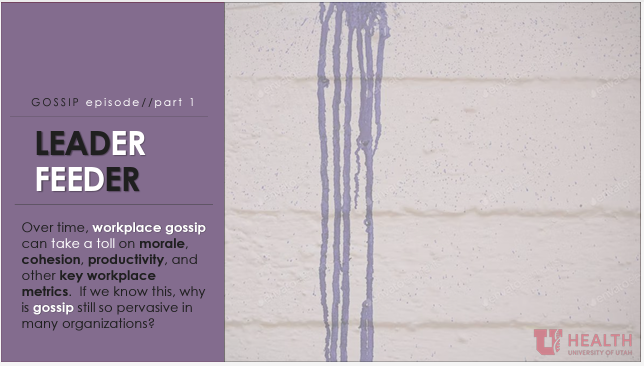ossip can destructively weave through an organization, leaving low morale, dissent, and disengagement in its wake. Despite our awareness of its detrimental effects, gossip continues to pervade many organizations, creating a toxic undercurrent that erodes trust and damages relationships. Why and how does workplace gossip persist despite its acknowledged harms?
Well, statistics paint a vivid picture of the prevalence of gossip within the workplace:
-
14% of coffee-break conversations qualify as gossip.
-
Between 65-90% of general conversations in the workplace qualify as gossip.
-
96% of employees admit to engaging in gossip.
Leaders gossip too–supervisors and above have (on average) 7.4 gossip partners compared to 3.9 gossip partners for front-line employees.
Defining Gossip and Its Complex Purposes:
Defining gossip isn't straightforward. Its contours blur, leaving room for ambiguity. To differentiate, one must consider its emotional charge, the intent to damage, and its unsupported nature.
Gossip, as perplexing as it is, serves multifaceted purposes–it offers an informational lifeline to those distrustful of formal channels, acts as an emotional outlet, and indirectly addresses interpersonal conflicts. Yet, therein lies the danger: gossip produces more gossip, perpetuating a cycle that corrodes workplace culture.
The Dangers and Benefits of Gossip:
The repercussions of gossip are vast and deeply impactful, eroding trust, productivity, and creativity, while fostering divisiveness and anxiety. However, acknowledging its benefits is essential.
Gossip, in the twisted logic of social systems, temporarily relieves pain, grants a sense of power, and forges social bonds. It's a diagnostic tool, albeit a flawed one, that helps identify deviations from group norms.
Based on the benefits (and consequences) associated with engaging in gossip, it is unlikely to ever have it disappear completely from the workplace. But, we can do a better job at keep harmful gossip at bay. These tools and strategies that will help you to create a healthy functioning workplace that breeds effective communication versus gossip.
Strategy #1: Don’t be an Enabler
Gossipers are often subtly or overtly rewarded when others passively respond or when they simply choose to listen. The silence often gets mistaken by the gossiper as validation or agreement. Take an active approach and force the issue or situation into the open.
1. Reduce the supply of gossip by decreasing the demand. Get ahead of gossip before reactions and emotions metastasize into gossip.
- Example: When important decisions are made, major changes are instituted, errors happen, or uncertainty is present–gather your team and outline details around decision making, deadlines, budgets, etc. Paint the picture of what is accurate and objective, and what is not.
2. Use credible communication channels to model candor and transparency. Fill the void with facts before assumptions and suspicion become “fact.”
- Example:: When important decisions are made, major changes are instituted, errors happen, or uncertainty is present–hold a department-wide synchronous or asynchronous meeting.
Ask questions such as:
-
Informational purpose - “Before the changes went into effect, was there anything about the situation that would have been helpful or useful to know?”
-
Emotional purpose - “How do you feel about the decision or change?”
-
Interpersonal purpose - “Was there anything I could have done differently to make the transition smoother or improved your experience with the change?”
Strategy #2: Encourage Direct Conversation
If you believe there is some truth or weight to the gossip your team member or colleague is sharing, try to get the concerns presented in a forum where they can be addressed constructively.
1. Encourage your team member or colleague to raise the issue directly with the person (or people) in question.
- Example: “Ben, I share your concern about Terry’s comments, but telling me isn’t going to make it better. I think you need to talk to Terry directly. I’m happy to help you think through how you would approach that conversation.”
2. Encourage your team member or colleague to get the issue out in the open.
- Example: “Ben, I share your concern about Terry’s comments and agree he shutdown the conversation before we had time to give the idea a chance. Why don’t we ask if we can have your ideas put back on the agenda for our next meeting?”
3. Encourage your team member or colleague to remove the third party from the conversation.
Clarify you are happy to talk about the situation and the underlying emotions – just not about people who aren’t there to defend themselves.
- Example:: “Ben, how did you feel when Terry said your ideas would never work?...What was your intent when you responded to Terry?...How are you thinking about the next steps?”
Example:Strategy #3: Start a Proactive Conversation
Often, gossip keeps people stuck in the past and having backward-looking conversations. Redirecting the conversation to a proactive stance can move people past their personal reactions to situations and move on to a constructive plan.
1. Coach your team member or colleague on better ways to approach the situation (now and in the future).
- Example: “Let’s brainstorm together how might you get people on board with new ideas and plans earlier in the future?...What does Terry look for in a presentation or pitch, and how might you play to his style next time so that the information will better resonate with him?”
2. Provide your own feedback about the situation that includes a way forward.
- Example: “When I heard your presentation this morning, like Terry, I too had some concerns about your plan. When you responded to Terry by saying you would ‘figure out the details later’ and ‘everything would be handled,’ I didn’t feel confident. Here is what it would take to get me on board with the overall idea and plan of execution…”
Strategy #4: Be a Role Model and Promote Fellowship
Team members look to leaders as messengers of organizational values. Consistently demonstrating integrity and inclusion in your speech, policies, actions, and decisions will help employees follow suit.
1. Lead with empathy, ethics, and cooperation
- Example: “Ben, I would like to verify what has been said, done, and occurred with Terry before I make any final decisions on how to proceed. You know my expectations and value around maintaining an environment where we work with facts and do our due diligence in gathering information that is accurate and fair. May I please get your cooperation in this effort?”
2. Advocate for and sponsor team building, organizational events, and one-on-one meetings.
The more trust and cohesion is built on a team, the less likely members are to malign one another.
- Example:: Encourage team members to spend time together to get to know each other as people, not just coworkers or colleagues. Connect team members based on their interests, ambitions, skill set, etc.
- "Ben, your ideas are always so creative and forward thinking. I would like to have you and Jasmine meet. Together I believe you both could generate new solutions to some of our current issues surrounding limited resources.”
In the complex web of workplace dynamics, gossip appears to be an inevitable facet. Its roots run deep, intertwined with human nature and social structures.
However, accepting its inevitability does not mean surrendering to its corrosive effects. By adopting proactive strategies, nurturing open communication, and leading with empathy and integrity, organizations can mitigate the impacts of gossip. It's a journey toward a healthier, more supportive workplace – a place where trust is nurtured, conflicts are resolved constructively, and the toxic tendrils of gossip find no fertile ground. Embracing these principles, we can pave the way for a workplace where genuine communication prevails, fostering an environment where individuals thrive, not despite gossip, but in its absence.
Jessica Burgett
To disagree means failing to agree. Synonyms include to contradict, challenge or debate. Synonyms do not also have to include to argue, quarrel, dispute, bicker or clash. Pediatric intensivist Jared Henricksen shares the best path forward when words become clouded with emotion.
Learning to listen is not only a leadership skill—it’s a life skill. Leadership training specialist Jess Burgett shares three practical tips for harnessing the power of listening with intent.
Its that time of the year, when respiratory illnesses are common. Masking is one way we can protect our most vulnerable patients and ourselves. Use the below guide to discuss masking with your teams and with our patients.

